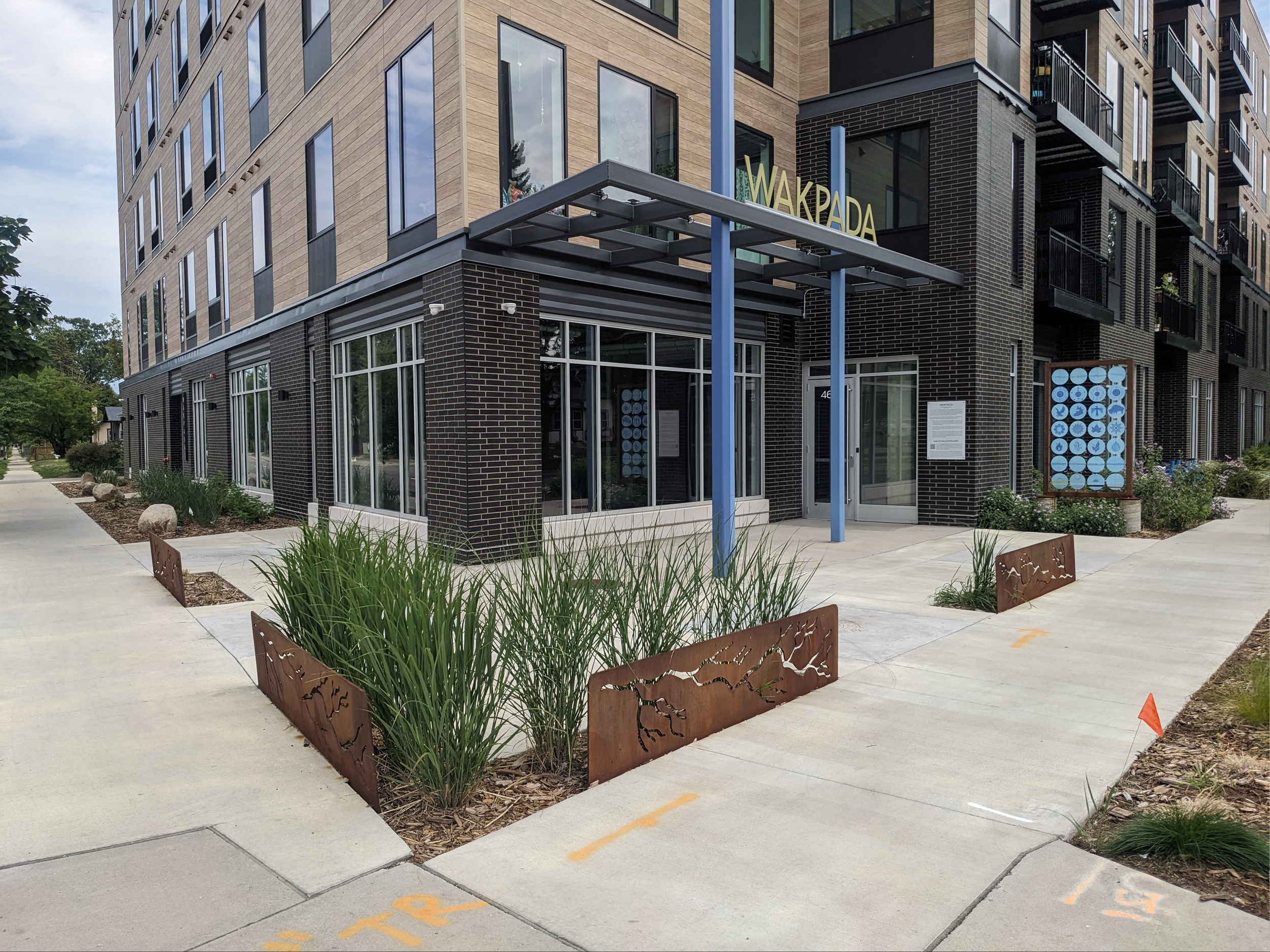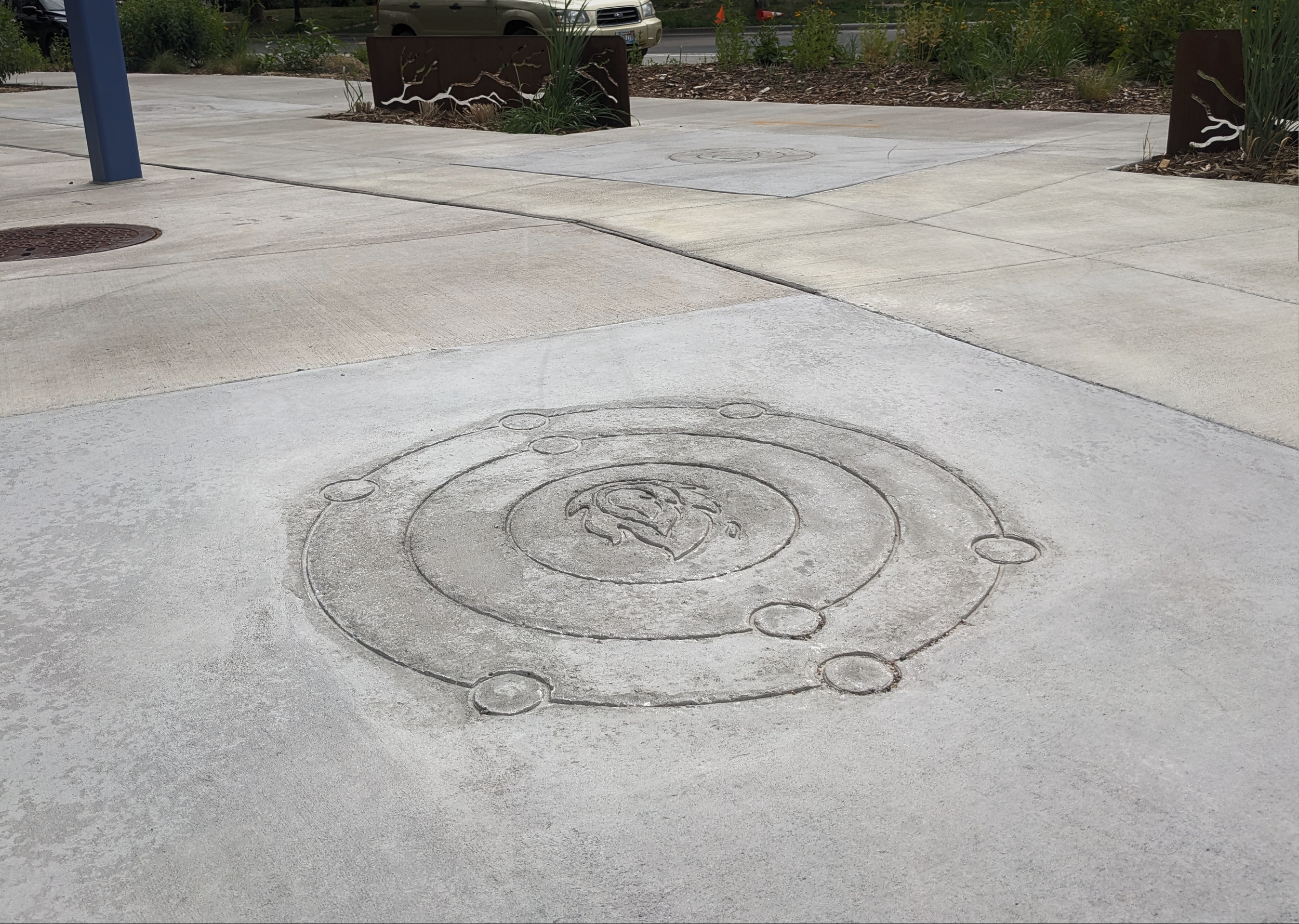Angela Two Stars Lets Life Flow at Wakpada Apartments
For local Dakota artist Angela Two Stars, finishing the installation of Okciyapi was a huge step in her career as a public artist. But finishing such a large project left her feeling aimless.
“It was a whole process itself–a journey, a celebration,” says Angela. “And afterwards it was kind of like, ‘And then what am I gonna do?’”
Jeff Hall of Hall-Sweeney Properties offered an answer to that question when he reached out to Angela about designing a artwork for their new apartment building, located in Minneapolis’s Hiawatha neighborhood. The building’s name–Wakpada, meaning “creek” in the Dakota language–and Hall-Sweeney’s approach to the project intrigued her.
“It wasn't just another apartment building going up,” says Angela, “it was more intentional in acknowledging the Dakota people and honoring our language.”
Hall-Sweeney partnered with Dakota Language Instructor Sisoka Duta as a language and culture consultant, in an effort to center Dakota language and culture through the development process.
The plaza at Wakpada apartments, designed by Angela Two Stars.
For this project, Angela was both an artist and a consultant to Hall-Sweeney, offering feedback on RFPs and suggesting artists whose work could become part of the building’s interior. With Angela’s help, Hall-Sweeney worked with Dakota, Ojibwe, and Cree artists to beautify the interior of the apartment building, including photographers Ne-Dah-Ness Rose Greene and Jordan Iwan, painter Brian Dow, and muralist Gordon Coons. Ensuring a variety of Native artists were included was important to Angela.
“It shows the general public that we’re not just this generalized plains Indian, you know,” Angela says. “There’s all these different Native communities that have different identities, cultures, languages…. Tenants can know more about the different tribal peoples that live within their neighborhood.”
Angela herself was responsible for creating a dynamic courtyard reflecting the history of the area. She set about designing this installation by pondering a simple phrase: “Let Life Flow.”
“I was thinking about life and the elements of life,” says Angela, “You know, like oxygen, nitrogen, hydrogen, phosphorous. And then [I thought about] how that ties into the four directions.”
Two of the sidewalk stamps Angela designed. The left is based on carbon and fire, and the right on phosphorous and earth.
The four cardinal directions, Angela says, are associated with the medicine wheel and are an important part of Native American culture. Each direction has other associations with meaning.
“Birth, childhood, adulthood, elder years,” she explains. “There’s the four seasons. There’s fire, wind, water, earth.”
All in all, Angela created designs for seven different groups of four associated with life and teachings of the medicine wheel. Some of those–the elements of life, and the classical elements of fire, wind, water, and earth–she incorporated into sidewalk stamps in front of the building. The rest hung in her mind as she designed the most complex piece of the project: a tall, rectangular weathered steel frame around a grid of 28 enameled steel circles.
The twenty-eight enameled steel circles, hanging from a weathered steel frame. The designs shown reflect groups of four that are important in Dakota culture, many of which are associated with the medicine wheel.
“I wanted to use circles, because in our culture, a circle is a sacred shape. It has no beginning, no end,” she says. “And then I was also thinking about the seven generations teachings, and how we are to lay out our lives and take care of the earth with the seventh generation in mind.”
One side of each panel is designed to emulate the flow of water. The other side has designs, color, or words in the Dakota language in groups of four, depicting different teachings of the medicine wheel.
The final element of Angela’s installation is a series of weathered steel planters, with branching patterns reminiscent of a river or creek–a nod to the building’s name and the location.
“Just down the street is Minnehaha falls. And then down the way is Bdote,” Angela says, “so the planters’ design and the name of the building are reinforcing place and Dakota history at the site.”
Another view of the enameled steel grid, featuring patterns that emulate water flowing.
Angela made great use of CAFAC’s resources to fabricate the project, just as she did when working on Okciyapi and Under the Surface, We Are All the Same. At CAFAC, she was introduced to vitreous (or porcelain) enameling, which she now uses in a variety of artwork. Enameling is a process of fusing glass powder to metal with a kiln, creating a strong, durable finish that has been known to last hundreds of years.
“It’s been one of my favorite mediums to work with now,” she says. Despite her experience, Angela says she learns something new with each project. This time, the team tried a new drying process for the enamel graphics coat, and small errors in Angela’s enameling technique became apparent.
“I think I had made my enamel too thick and so it was chipping off. I had to grind it down–I’ve never had to do that before and it was not fun, but it’s like ‘Ooh, here’s something new that I get to learn about enamel!” she laughs.
After painstakingly grinding and re-coating each piece, the final piece of the sculpture was installed at Wakpada in the spring of 2023.
Angela says she hopes her sculpture will allow community members–Native and non-Native–to deepen their understanding and appreciation of Dakota culture. The project serves as a reminder that the Dakota people are still here.
“Native American history has been kept from everybody, including me. I didn’t know that Minnesota was my ancestral homeland until I graduated from high school,” Angela says. “Now, I’m learning all of this information about sacred sites that I didn’t know growing up on a reservation in South Dakota.”





